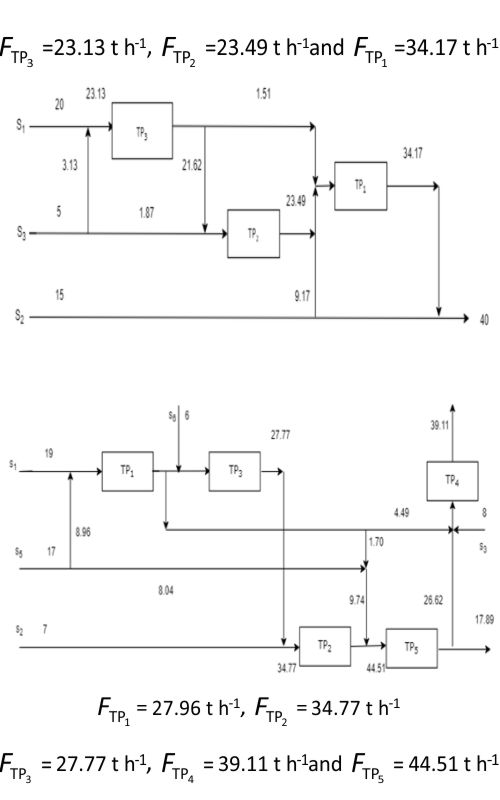A systematic approach for design of distributed wastewater treatment systems Original scientific paper
Main Article Content
Abstract
Due to increasingly strict environmental regulations, the cost of handling various waste streams is gradually rising. Therefore, it is crucial to minimize unnecessary stream merging when designing distributed wastewater treatment systems, to reduce the overall treatment flow rate whenever possible. In a distributed wastewater treatment system, the wastewater streams are separated for treatment and only combined when necessary. This results in a significant reduction in the total treatment flow rate compared to traditional centralized treatment systems where all the streams are merged before treatment. Design of a distributed wastewater treatment system can be accomplished using pinch analysis and mathematical programming approaches. This paper suggests a straightforward approach for designing such networks, with the following steps in the design process: First, the primary function of each treatment unit is determined. Next, using the pinch method, the lowest treatment quantity is determined for the primary pollutant for each unit. Finally, a three-unit group is selected, with the pinch stream partially treated, the streams above the pinch completely treated, and the stream below the pinch completely bypassed. Two literature case studies demonstrate the viability and effectiveness of this strategy.
Article Details
Issue
Section

This work is licensed under a Creative Commons Attribution-NonCommercial-NoDerivatives 4.0 International License.
Authors who publish with this journal agree to the following terms:
Authors retain copyright and grant the journal right of first publication with the work simultaneously licensed under a Creative Commons Attribution License that allows others to share the work with an acknowledgement of the work's authorship and initial publication in this journal.
Authors grant to the Publisher the following rights to the manuscript, including any supplemental material, and any parts, extracts or elements thereof:
- the right to reproduce and distribute the Manuscript in printed form, including print-on-demand;
- the right to produce prepublications, reprints, and special editions of the Manuscript;
- the right to translate the Manuscript into other languages;
- the right to reproduce the Manuscript using photomechanical or similar means including, but not limited to photocopy, and the right to distribute these reproductions;
- the right to reproduce and distribute the Manuscript electronically or optically on any and all data carriers or storage media – especially in machine readable/digitalized form on data carriers such as hard drive, CD-Rom, DVD, Blu-ray Disc (BD), Mini-Disk, data tape – and the right to reproduce and distribute the Article via these data carriers;
- the right to store the Manuscript in databases, including online databases, and the right of transmission of the Manuscript in all technical systems and modes;
- the right to make the Manuscript available to the public or to closed user groups on individual demand, for use on monitors or other readers (including e-books), and in printable form for the user, either via the internet, other online services, or via internal or external networks.
How to Cite
References
Wang YP, Smith R. Design of distributed effluent treatment systems. Chem Eng Sci. 1994; 49(18): 3127–3145, https://doi.org/10.1016/0009-2509(94)E0126-B.
Kuo WCJ, Smith R. Designing for the interactions between water-use and effluent treatment. Chem Eng Res Design. 1998;76(3): 287–301, https://doi.org/10.1205/026387698524938.
Ng DKS, Foo DCY, Tan RR. Targeting for total water network. 1. Waste stream identification. Ind and Eng Chem Res. 2007; 46: 9107-9113, https://doi.org/10.1021/ie071095h.
Bandyopadhyay S. Targeting minimum waste treatment flow rate. Chem Eng J. 2009; 152(2-3): 367-375, https://doi.org/10.1016/j.cej.2009.04.060
Liu ZH, Shi J, Liu ZY. Design of wastewater treatment networks with single contaminant. Chem Eng J. 2012; 192: 315-325, https://doi.org/10.1016/j.cej.2012.03.060.
Shi J, Liu ZY. A simple method for design of distributed wastewater treatment systems with multiple contaminants. AIChE J. 2011; 57(11): 3226-3232, https://doi.org/10.1002/aic.12510.
Liu ZH, Shi J, Liu ZY. Design of distributed wastewater treatment systems with multiple contaminants. Chem Eng J. 2013; 228: 381–391, https://doi.org/10.1016/j.cej.2013.04.112
Li AH, Yang YZ, Liu ZY. A numerical-indicator-based method for design of distributed wastewater treatment systems with multiple contaminants. AIChE J. 2015; 61(10): 3223–3231, https://doi.org/10.1002/aic.14863.
Karuppiah R, Grossmann IE.Global optimization for the synthesis of integrated water systems in chemical processes. Compu Chem Eng. 2006; 30(4): 650–673, https://doi.org/10.1016/j.compchemeng.2005.11.005.
Castro PM, Matos HA, Novais AQ. An efficient heuristic procedure for the optimal design of wastewater treatment systems. Resour Conserv Recy. 2007; 50(2): 158–185 https://doi.org/10.1016/j.resconrec.2006.06.013 .
Statyukha G, Kvitka O, Dzhygyrey I, Jezowski J. A simple sequential approach for designing industrial wastewater treatment networks. J Clean Prod. 2008; 16(2): 215–224, https://doi.org/10.1016/j.jclepro.2006.09.002.
Tudor R, Lavric V. Optimization of total networks of water-using and treatment units by genetic algorithms. Ind Eng Chem Res.2010; 49(8): 3715–3731, https://doi.org/10.1021/ie901687z.
Yenkie KM, Pimentel J, Orosz Á, Cabezas H, Friedler F. The P-graph approach for systematic synthesis of wastewater treatment networks. AIChE J. 2021; 67(7), https://doi.org/10.1002/aic.17253 .
Padrón-Páez JI, Prado-Rubio OA, Carvalho A, Román-Martínez A. NLP optimization for the design of sustainable wastewater treatment networks. Comput Aided Chem Eng. 2016; 38: 1503–1508, https://doi.org/10.1016/B978-0-444-63428-3.50255-1.
Zeferino JA, Cunha MC, & Attunes AP. Adapted optimization model for planning regional wastewater systems: Case study. Water Sci Tech. 2017; 76(5): 1196–1205 https://doi.org/10.2166/wst.2017.302.
Fan XY, Klemeš JJ, Jia X, Liu ZY. An iterative method for design of total water networks with multiple contaminants. J Clean Prod. 2019; 240, https://doi.org/10.1016/j.jclepro.2019.118098.
Denysiuk R, Santo IE, Costa L. Wastewater treatment plant design: Optimizing multiple objectives. In: Proceedings of the 7th International Conference on Operations Research and Enterprise Systems ICORES 2018, Funchal, Madeira, Portugal, 327–334, https://doi.org/10.5220/0006660303270334.
Padrón-Páez JI, Almaraz SDL, Román-Martínez A. Sustainable wastewater treatment plants design through multiobjective optimization. Comput Chem Eng. 2020; 140 https://doi.org/10.1016/j.compchemeng.2020.106850.
Hernández-Chover V, Castellet-Viciano L, Fuentes R, Hernández-Sancho F. Circular economy and efficiency to ensure the sustainability in the wastewater treatment plants. J Clean Prod. 2023; 384, https://doi.org/10.1016/j.jclepro.2022.135563.
Lim SR, Park D, Park JM. Environmental and economic feasibility study of a total wastewater treatment network system. J Environ Manag. 2008; 88(3): 564–575 https://doi.org/10.1016/j.jenvman.2007.03.022.





